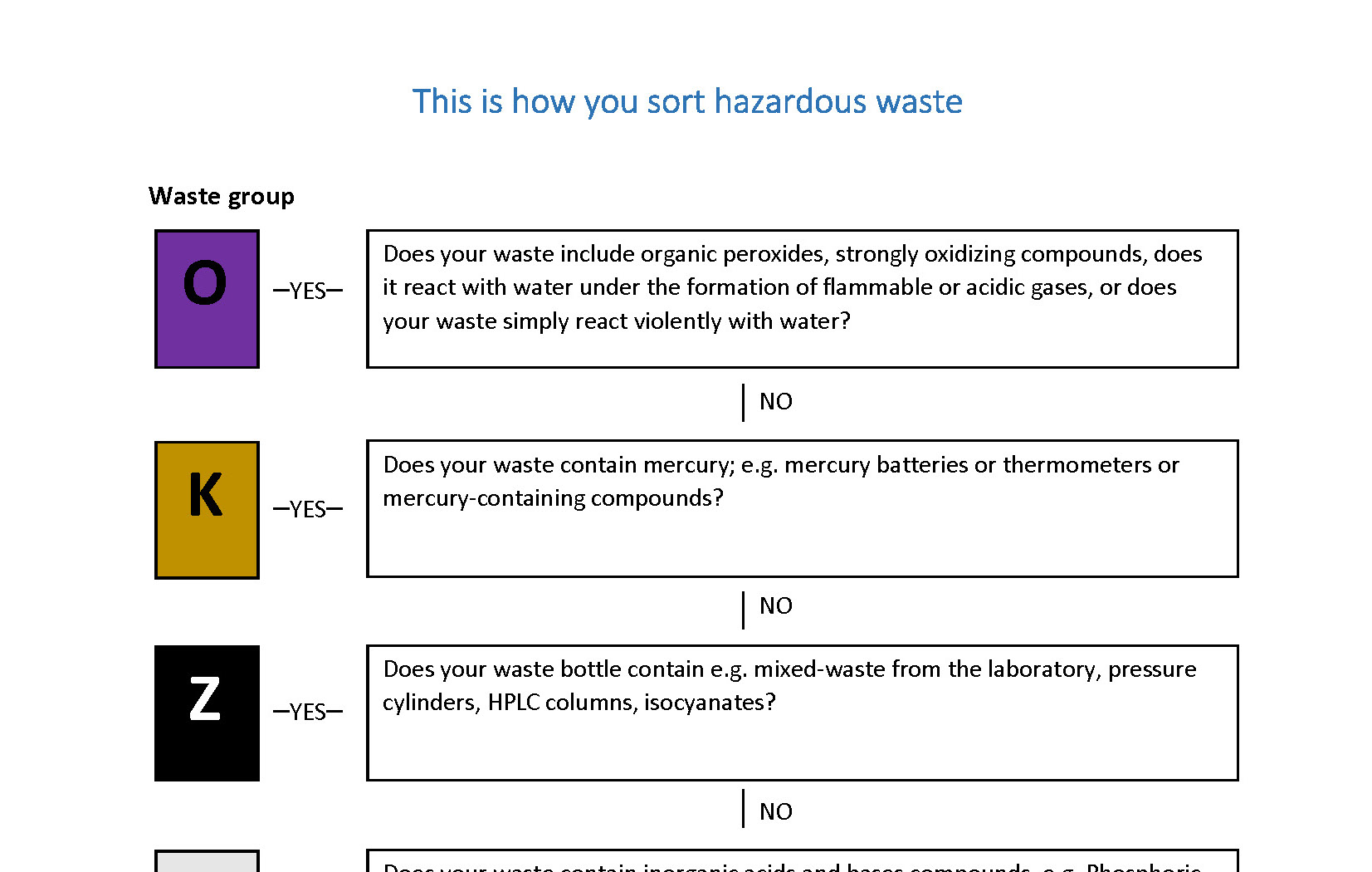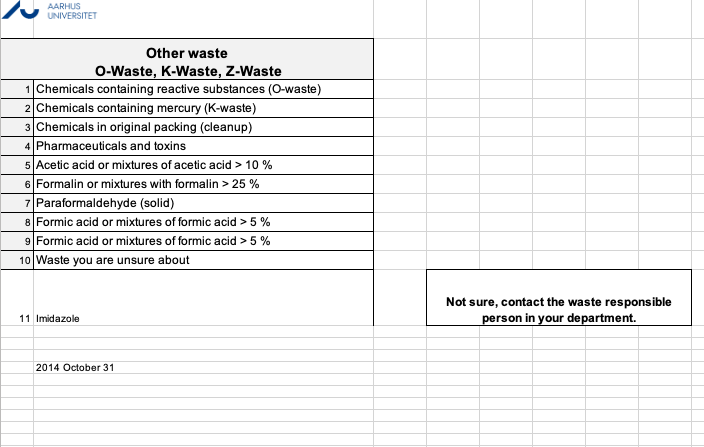Waste management

H - WASTE LIQUID
The constituents of the waste: Buthanol, > 25% ethanol, > 25% acetic acid (with larger quantities also collected below 25%, applies to both ethanol and acetic acid), approx. 1% Coomassie blue, methanol, acetonitrile, propanol, tetrahydrofuran, acetone, dioxane, guanidine hydrochloride. Small amounts (about 1%) of paraformaldehyde, silver nitrate, phosphoric acid, trichloroacetic acid and other halogens below 1%.
Liquid waste containers
Liquid waste must only be poured into approved 5 L containers, which are collected in room 1590-049.
Containers must only be filled to the top mark (See photo). The lid is screwed securely and tight with the special tool (found in room 1590-049). The waste containers are put into the correct transport bins in the waste room 1590-051. Filling and suggestions for marking as shown in photo.
H - WASTES SOLID
Waste constituents: Gels, napkins, pipette tips, gloves and the like with very small amounts of chemicals. Cannula boxes for needles and scalpels.
Dry GMO waste must be autoclaved and disposed of as ordinary waste.
H - WASTES FROM SCINTILLATION SELLERS AND ELISA CHARGERS
Waste constituents: Counting fluid OptiPhase Hisafe 3[JNP1] (including di-isopropyl naphthalene and polyethylene glycol mono-4-nonylphenyl ether)
Elisa plates with very small amounts of organic / inorganic chemicals (eg Bradford, Lowry).
B - WASTE LIQUID
Waste components: Chloroform, phenol, <10% isoamyl alcohol in tubes, trichloroacetic acid, sulfolane, acetone. Halogen over 1%. Notify your security representative if anything else is left in the list!
B - WASTE SOLID, CARBON FILTER
Waste constituents: Carbon filters and carbon bags with ethidium bromide residues REMEMBER: The carbon filters / carbon bags are wet and packed wet in plastic bag.
C - WASTE
Waste constituents: Equal to or more than 50% solvent. Collected in smaller containers in the laboratory, disposed of in barrel in waste container. Do not contain halogens.
Z - waste (chemicals)
Waste constituents: Mixed laboratory waste from clean-up.
A barrel: for solid Z-waste - write consecutive numbers, the chemical name, the quantity (in%), your initials and group names in the logbook.
A barrel: for liquid, corrosive and acidic - as stated above, write in the logbook on the barrel.
A barrel: for liquid, corrosive and basic - as stated above, write in the logbook on the barrel.
Remember: O waste must always be packed in a barrel by itself.
You may pack 2 mercury thermometers or mercury lamps at the top of the barrel in a thick plastic bag, if you write it under “affaldets bestanddele” ("The components of the waste")
Z - WASTE - SPRAY CANS
Waste components: Empty spray cans as well as empty small butane gas cans
O - WASTE - REACTIVE WASTE
Waste components: See the list of "O substances" (reactive substances)
It must be written in the book which substances come in the barrel, as the different types of reactive waste must be kept separate from each other.
An O-waste barrel, especially for hydrogen peroxide 20 - 60%
X - WASTE, LIQUID AND HEAVY METALS
Waste constituents: Elisaplader with small amounts of heavy metals. Liquid nickel chloride and copper sulfate from columns. Notify your safety representative if any metals other than nickel and copper are being poured.
A - WASTE, SPILL OIL
Waste components: Engine oil (not chlorinated oil, Fp over 61 ° C), oil from vacuum pumps.
FOR BATTERIES IN GENERAL
There is a box in the student helpers office for used batteries
GMO waste
All solid waste must be autoclaved and disposed of as ordinary waste. Liquid waste can be autoclaved or treated with Virkon S (10/00) and then poured into the sink.
Radioactive waste
After storage for 10 half-lives, radioactivity has decreased to approx. 1/1000. This will often be an appropriate time for contaminated glassware and other highly radioactive waste.
32P waste must be stored for 5 months
35S and 33P waste must be stored for 30 months
125I waste must be stored for 20 months
After storage it can be considered as ordinary, non-radioactive waste. Waste after iodination (solid form e.g. in gel matrix or aspirated into absorption material or absorbent of the like) is stored in closed 1" steel tubes which are stored for at least 20 months.



